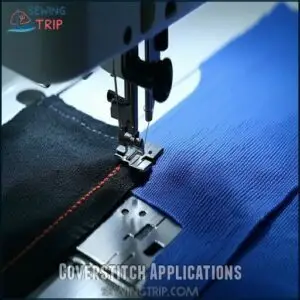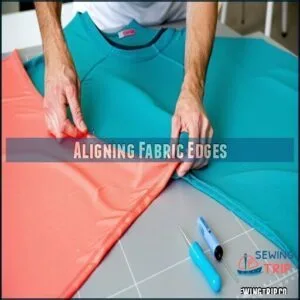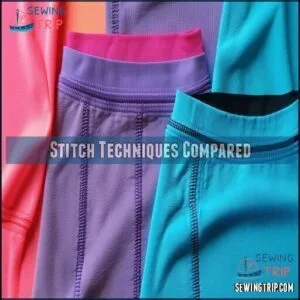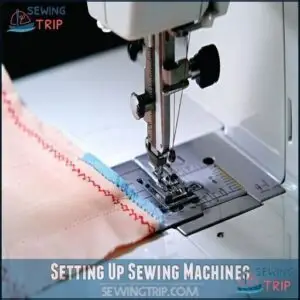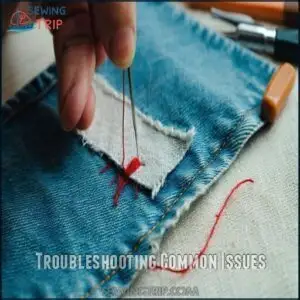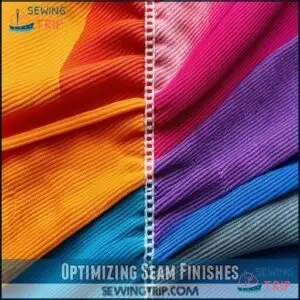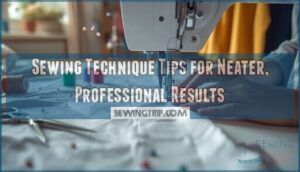This site is supported by our readers. We may earn a commission, at no cost to you, if you purchase through links.
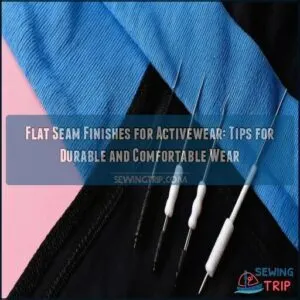
Flatlock stitches create a smooth, low-profile connection that lies flat against your skin, while coverstitches offer excellent stretch recovery for high-movement areas.
For compression garments, consider French seams turned outward or bound seams with soft elastic binding.
When sewing your own, use a serger with proper tension settings and ballpoint needles to maintain fabric elasticity.
The right thread matters too—polyester core-spun threads resist breakage during stretching.
The difference between comfort and distraction often comes down to these invisible details beneath the surface.
Table Of Contents
Key Takeaways
- You’ll find flatlock stitching creates smooth, low-profile seams that prevent chafing during intense workouts, making it ideal for high-movement activewear.
- You can choose from several stitch types based on your specific needs—coverstitches offer excellent stretch recovery, while bound seams with soft elastic binding work well for compression garments.
- You’ll need to properly set up your machine with the right thread tension, ballpoint needles, and polyester core-spun threads to maintain fabric elasticity and prevent breakage during stretching.
- You should position seams strategically away from high-friction areas and use moisture-wicking fabrics with four-way stretch to further reduce irritation and enhance comfort during athletic performance.
Choosing Right Stitches
When choosing stitches for activewear, focus on ensuring comfort, durability, and flexibility to match the garment’s purpose.
Consider the fabric type, stretch requirements, and intended use to select stitches like flatlock, coverstitch, or overlock for the best results.
Factors Affecting Stitch Selection
Stitch selection for flat seam activewear depends on fabric properties, activity intensity, and seam placement.
Fabrics with stretch demand flexible stitches like flatlock stitching, guaranteeing durability. Activewear seams should reduce friction while meeting aesthetic goals.
Balancing cost considerations with performance is key. For best results, consider fabric type considerations to guarantee compatibility.
Choose stitches that complement fabric composition to maximize comfort, functionality, and style during high-intensity activities.
Importance of Fabric Type
When choosing stitches, fabric types make a big difference in performance and durability.
For flat seam activewear, consider:
- Fiber Properties: Stretchy materials like spandex need Stitch Compatibility.
- Material Weight: Lightweight knits demand precise tension to prevent distortion.
- Weave Structure: Looser weaves may fray without reinforcement.
A stitch should complement fabric composition, especially for activewear’s flexibility and comfort.
Considerations for Athletic Wear
In the context of athletic wear seams, your focus should be on Seam Comfort, Stitch Durability, and Movement Flexibility.
Using flatlock stitching creates chafefree seams that keep you comfortable during every stretch.
Seamless activewear and comfortable activewear seams also reduce chafing and maximize Fabric Performance.
For true freedom of movement, prioritize stitching that’s strong yet smooth—perfect for any workout, ensuring Movement Flexibility.
Flatlock Stitch Benefits
You’ll love flatlock stitching for its ability to create smooth, bulk-free seams that feel great against your skin.
It’s a reliable choice for activewear, providing durability and minimizing irritation during movement.
Future Of Artificial Intelligence
Although AI advancements drive incredible innovation, they’re reshaping industries like flatlock stitching in seamless activewear.
Autonomous systems now optimize chafe-free seams for performance apparel, creating durable, comfortable activewear seams.
Imagine AI adding creativity to your sewing processes—streamlining designs and ensuring quality.
However, job displacement raises concerns as machines take over.
Still, these technologies promise unmatched precision for performance wear.
Ethical Implications Of AI
With AI’s rise, ethical concerns demand attention—even in sewing.
Flat seam construction leverages activewear technology for comfort, yet AI bias in design tools could affect inclusivity.
Consider:
- Data Privacy: Protect consumer designs.
- Job Displacement: Balance automation and creativity.
- Algorithmic Transparency: Guarantee fair outcomes.
- Autonomous Weapons: Monitor misuse parallels.
- Seam Finishing Techniques: Keep focus on durable activewear seams.
AIs Impact On Jobs
Just as flatlock stitching revolutionizes activewear with strength and comfort, AI reshapes jobs, blending innovation with challenges.
AI job displacement sparks workforce adaptation, while skillset evolution becomes key to navigate automation’s future.
For seamless leggings or ethical considerations, the focus remains on crafting value—whether through flat seam construction or embracing technology’s shift with resilient, forward-thinking approaches that require adaptation.
Coverstitch Applications
You’ll find coverstitch invaluable for creating strong, flexible hems that move with your activewear.
It’s also perfect for attaching elastic securely, ensuring a polished finish that won’t let you down during intense workouts, making it a crucial element for activewear.
Uses in Knitwear and Activewear
In activewear design, coverstitching guarantees seamless shifts between functionality and style.
It excels in knitwear and activewear, enhancing performance fabrics with flat seam benefits, like reduced friction and improved stretch.
Seam placement is vital—it minimizes irritation during movement.
Beyond durability testing, coverstitching also adds aesthetic design versatility, making it perfect for flat seam sewing in leggings, sports bras, and dynamic garments.
Hemming and Attaching Elastic
A coverstitch is your go-to tool for hemming and attaching elastic in activewear. It guarantees stretch without compromising durability.
- Use durable elastic types for waistbands or cuffs.
- Adjust tension settings to prevent puckering.
- Select stitch length suited for the fabric’s flexibility.
- Reinforce seams in high-stress areas.
- Combine flat seam benefits with clean hemming techniques for smooth, irritation-free finishes to ensure a comfortable wear experience with durable construction.
Decorative Finishes on Casual Wear
You’ve mastered hemming elastic for activewear; now, bring flair to casual wear with decorative finishes.
Use stitch patterns like flatlock stitching to create unique designs, adding color contrasts or texture variety.
For ideal results, adjust thread tension for balanced stitches.
Try unique threads for bold looks. These casual embellishments turn flat seam finishes into stylish statements, blending comfort and function.
It’s the perfect touch for casual wear with personality.
Flat Seam Construction
You’ll construct flat seams by aligning fabric edges side by side to minimize bulk and guarantee a smooth finish.
Secure the seam allowances with precise stitching to create durable, low-profile seams ideal for activewear.
Creating Low-Profile Seams
Ever wonder why some seams feel so smooth and invisible? Creating low-profile seams reduces bulk and boosts comfort in activewear.
Use flatlock stitching to join edges for flat seam finishes that eliminate irritation. Match stitch density for durability and performance enhancement.
- Smooth finish: No seam bulk reduction enhances wearability.
- Irritation-free: Perfect for athletic wear.
- Edge alignment: Even layers improve aesthetics.
- Stretch-ready: Supports active movement.
Aligning Fabric Edges
For precise flatlock stitching, fabric alignment is key. Prep edges by trimming uneven parts and press lightly.
Use pinned seams or basting techniques to stabilize fabric. Keep edges flat and even to avoid shifting during sewing.
Proper seam types and grading minimize bulk, ensuring durability and flexibility in activewear seams. Well-prepared edges make flatlock stitching effortless.
Securing Seam Allowances
Securing seam allowances guarantees durability and comfort in activewear.
Use grading seam and trimming allowances techniques to reduce bulk. Pressing techniques are key—always press seams open for a polished look.
For flatlock stitching or a mock flat-fell finish, align edges accurately, enclosing seams for smooth results.
These steps create flat, professional seam finishes, minimizing irritation during movement.
Stitch Techniques Compared
When comparing stitch techniques for activewear, you’ll notice how each impacts comfort, durability, and flexibility.
From flatlock to coverstitch, understanding their unique strengths helps you select the best option for any project, considering factors like durability.
Flatlock Vs Coverstitch
When debating flatlock stitching vs. coverstitch for activewear, focus on their unique strengths.
- Seam Flatness: Flatlock offers a bulk-free finish, reducing chafing.
- Stitch Stretch: Coverstitch shines for knit elasticity, making hems durable.
- Best Applications: Flatlock suits performance apparel seams, while coverstitch adds polished hems for athletic wear.
Choose based on comfort, durability comparison, and aesthetic differences.
Overlock and French Seams
Overlock stitches stand out for activewear with their durability and ability to neatly finish raw edges, while French seams shine in creating smooth, enclosed finishes.
However, French seams can add bulk, making them less ideal for stretchy fabrics. To achieve professional results, it’s important to understand overlock tension settings.
Here’s a quick comparison:
| Stitch Type | Durability | Flexibility | Best Use | Bulk Level |
|---|---|---|---|---|
| Overlock Stitch | High | Moderate | Activewear seams | Low |
| French Seam | Moderate | Low | Delicate fabrics | High |
Bound Seams and Their Limitations
Compared to overlock or French seams, bound seams add polish but can fall short in activewear.
Here’s why:
- Bound Seam Bulk: These seams add thickness.
- Flexibility Limitations: They restrict stretch.
- Aesthetic Tradeoffs: Looks sharp but feels stiff.
- Construction Complexity: Takes extra time and tools.
- Alternative Finishes: Flatlock might work better for athletic wear.
Choose wisely for comfort!
Setting Up Sewing Machines
Getting your sewing machine ready for flat seam finishes takes careful adjustments to guarantee smooth and durable stitching.
You’ll need to fine-tune the thread tension, select the right needles, and keep the machine well-maintained for consistent results.
Configuring for Flatlock Stitch
Flatlock stitching shines for activewear by creating smooth, flat seams. Start by adjusting machine settings: remove the right needle, lower thread tension to 0-3, and align the fabric feed.
Flatlock stitching transforms activewear with silky-smooth seams—just remove the right needle, drop tension, and watch the magic happen!
Keep the differential feed steady to avoid puckers. Many seek resources for flatlock stitch products to enhance their sewing setup.
Here’s a quick guide:
| Setting | Adjustment |
|---|---|
| Needle Choice | Remove right |
| Thread Tension | Loose (0-3) |
| Differential Feed | Steady |
Thread Selection and Tension
Choosing the right thread type is vital for flatlock stitching in activewear.
A strong, stretchy thread guarantees tension balance, maintaining seam strength without snapping.
Adjust stitch tension for smooth, even stitching—too tight can pucker fabric, too loose weakens the seam.
Machine compatibility is key; test threads to perfect stitch appearance across different seam types for reliable results.
Incorrect thread placement often leads to tension related issues.
Maintaining Machine Performance
Thread tension isn’t everything—your sewing machine setup demands regular care for flatlock stitching to shine. Preventative care keeps things smooth.
- Needle Maintenance: Replace dull needles often for even seams.
- Regular Cleaning: Dust buildup can hinder performance; clean parts weekly.
- Oiling Mechanisms: Lubricate moving parts to avoid stiffness.
Proper maintenance includes knowing when to follow a needle replacement guide. Reliable upkeep guarantees those perfect, durable seams every time!
Troubleshooting Common Issues
You’ll occasionally run into challenges like skipped stitches or puckered seams when working on flat seam finishes.
Understanding how to adjust tension, fix threading issues, and prevent fabric distortion will keep your activewear projects on track, which involves grasping the concept of complete concepts to ensure a smooth workflow.
Identifying and Fixing Errors
Skipped stitches, uneven seams, puckering fabric, or thread breaks slowing you down? Don’t fret—start by double-checking your stitch settings and thread tension.
Misaligned flatlock stitching often stems from improper sewing machine setup. Inspect for loose needles, wrong thread type, or lint buildup.
Sewing troubleshooting tip: Clean your machine frequently to avoid tension problems and keep those seams smooth and flawless! This will also help prevent tension problems.
Adjusting Tension and Thread
Precision makes the difference when achieving perfect flat seams in your activewear projects.
Proper thread tension and selection substantially impact stitch quality and durability.
- Match thread type to fabric weight—lightweight polyester for spandex blends, wooly nylon for extra stretch
- Adjust upper tension first when troubleshooting skipped stitches
- Balance both loopers for even stitch appearance
- Test tension settings on fabric scraps before sewing garments
- Reduce tension slightly when working with four-way stretch materials
Achieving the right balance requires understanding activewear thread tension. It is crucial to find the right balance for your projects, considering factors such as thread type and fabric weight to ensure the best results.
Preventing Fabric Distortion
Now that you’ve mastered proper tension adjustments, let’s tackle fabric distortion—the nemesis of flatlock stitch perfection.
To prevent your athletic wear fabrics from stretching unevenly, always use fabric stabilization techniques.
Maintain consistent seam allowance and apply even pressure while sewing.
For stretch materials, reduce stitch density slightly.
Proper cutting techniques, including using sharp scissors and pinning perpendicular to edges, guarantee irritation-free activewear with professional-looking tension control throughout your flat seams.
Optimizing Seam Finishes
You’ll achieve professional-quality activewear by fine-tuning your seam techniques to eliminate friction points that cause discomfort during movement.
Your finished garments will last longer and perform better when you implement proper thread tension adjustments and strategic seam placement in high-stress areas.
Enhancing Durability and Comfort
To enhance seam durability and comfort in your activewear, select flatlock stitches for high-stress areas.
This specialized technique creates a flat seam that withstands repetitive movement while maintaining comfort.
For maximum stitch strength, use quality threads designed for athletic wear durability.
When constructing garments, maintain consistent tension throughout—this prevents weak points that compromise performance.
Remember, comfort factors like thread selection and stitch placement directly impact your activewear’s longevity and feel against skin.
Reducing Friction and Irritation
During intense workouts, friction from poorly constructed seams can cause painful skin irritation.
Shoddy seams turn dream workouts into nightmares—skin irritation shouldn’t be part of your fitness routine.
Your comfort depends on choosing the right seam techniques to minimize chafing.
Here’s how to reduce friction in your activewear:
- Select flatlock stitches for smooth, low-profile seams
- Choose moisture-wicking fabrics with four-way stretch
- Position seams away from high-friction areas
- Use wooly thread for increased seam comfort
By following these steps, you can significantly improve your overall comfort during workouts by reducing friction from seams.
Achieving Professional-Quality Results
Now that you’ve minimized irritation, let’s focus on making your seams look professionally crafted.
Consistent stitching is key to a professional appearance in athletic apparel.
Maintain accurate seamlines by marking fabric beforehand.
Grade seam allowances carefully for a smooth finish.
When working with flatlock stitch, guarantee precise topstitching by using proper tension settings.
For flat seams in activewear, press thoroughly between steps—professionals never skip this vital detail to achieve a professional appearance.
Frequently Asked Questions (FAQs)
How to sew flatlock seams without specialized equipment?
Use a regular zigzag stitch on your home sewing machine.
Set it wide and loose, then trim close to the stitching.
Pull the seam flat to create that distinctive ladder effect between fabric edges.
What causes puckering in flat seams?
Puckering in flat seams typically results from incorrect tension settings, uneven fabric feeding, or mismatched fabrics.
You’ll also see puckering when thread tension‘s too tight or you’re using improper needle size for your material, which can be considered a complete concept in understanding the causes of puckering.
Are flat seams suitable for swimwear?
Yes, flat seams are ideal for your swimwear.
They’ll reduce chafing against wet skin, create a smooth silhouette, and withstand chlorine and saltwater.
They’re especially comfortable for extended wear during water activities.
Can flat seams be repaired effectively?
Flat seams can be repaired effectively with the right tools and techniques.
You’ll need a serger or specialized machine to maintain the smooth finish and stretch properties that make these seams ideal for athletic movement.
How do flat seams affect garment longevity?
Strong as an ox, flat seams dramatically extend your garment’s life by reducing stress points and preventing fraying.
They won’t weaken with washing and maintain structural integrity during stretching, ensuring your activewear lasts substantially longer with strong construction.
Conclusion
When the rubber meets the road, your athletic performance depends on details as small as your seams.
By selecting the right flat seam finishes for activewear, you’ll eliminate distractions and focus on what matters—your workout.
Whether you choose flatlocks for compression gear or coverstitches for high-stretch areas, proper technique and materials guarantee comfort that lasts.
Remember, your activewear should work as hard as you do—with invisible engineering that supports every move you make.





